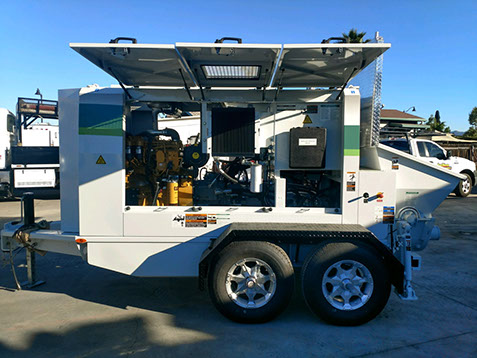In the bustling world of construction, where towering skyscrapers rise and sprawling infrastructure projects reshape skylines, concrete line pump operators play a pivotal role. These skilled professionals operate specialized machinery that pumps liquid concrete through hoses and booms to precise locations on job sites, ensuring foundations, walls, and slabs are poured efficiently and accurately. It’s a job that demands a blend of technical know-how, physical stamina, and quick decision-making amid unpredictable conditions like weather shifts or site hazards.
But as artificial intelligence (AI) and automation infiltrate every corner of the industry, a pressing question looms: Will these technologies render human operators obsolete?The construction sector, valued at trillions globally, is no stranger to mechanization. From robotic bricklayers to drone surveys, innovation has long aimed to boost productivity while tackling labor shortages. Yet, for concrete pumping—a niche but essential process—AI’s encroachment feels particularly acute. As of 2025, advancements in smart systems and autonomous equipment suggest a seismic shift. But does this mean the end for the operator’s seat, or merely a reconfiguration of it? Let’s dive into the evidence.
The Evolving Landscape of Concrete Pumping
Concrete line pumps, often trailer-mounted or truck-delivered, have traditionally relied on human oversight to manage flow rates, pressure adjustments, and boom positioning. Operators must navigate variables like concrete viscosity, hose lengths up to hundreds of feet, and elevation changes, all while prioritizing safety to avoid collapses or spills that could endanger lives.Enter AI and automation. Recent trends show a surge in “smart” pumping systems that integrate AI algorithms to automate core functions. For instance, these systems can dynamically adjust pressure, flow rate, and timing based on real-time data from sensors monitoring material density and site conditions. Predictive maintenance powered by machine learning analyzes equipment health to forecast failures, slashing downtime by up to 30% in some cases. IoT-enabled pumps provide remote monitoring, allowing operators to track performance via apps from off-site locations.Robotics and remote controls are also game-changers. Modern booms can self-position with GPS and AI guidance, integrating with Building Information Modeling (BIM) software for seamless workflow optimization. At events like the 2025 Bauma Expo, companies unveiled fully autonomous prototypes capable of handling pours without constant human input. The market for autonomous concrete pump booms alone is exploding, valued at $1.54 billion in 2024 and projected to reach $4.35 billion by 2033, growing at a 12.3% CAGR. This boom—pun intended—is fueled by urbanization in emerging markets and a global push for efficiency amid skilled labor gaps.
The Promise and Perils of AI-Driven Efficiency
Proponents of automation tout undeniable benefits. Safety tops the list: Remote operation keeps operators away from high-risk zones, while AI’s hazard detection—spotting anomalies like pressure spikes or structural weaknesses—prevents accidents. In the UK, for example, robotic systems have reduced manual handling injuries by enabling precise, error-free pours on complex urban sites. Efficiency follows suit; automated flow regulation minimizes waste, and high-capacity pumps handle larger volumes over greater distances, speeding up projects and cutting costs.
For the environment, AI optimizes resource use, from eco-friendly electric trailer pumps that adjust outputs to reduce energy consumption to mix-on-site solutions that lower emissions. Contractors report faster timelines and predictable outcomes, crucial in an industry plagued by delays.Yet, the flip side casts a shadow over jobs. Automation excels at repetitive tasks but struggles with the nuanced judgment operators bring—like adapting to sudden site changes or troubleshooting unique material issues. Still, data paints a sobering picture: Pump operators (excluding wellhead varieties) face a 75% automation risk, classified as “high” due to the feasibility of tech replacing monitoring and control duties. Employment in the U.S. stands at about 11,570 as of 2023, with modest 5% growth projected by 2033—far outpaced by automation’s pace. Globally, the concrete pumps market is set to hit $8.77 billion by 2032, but much of that growth hinges on labor-saving tech.
Human Oversight: The Irreplaceable Element?
Industry voices strike a balanced tone. While AI handles the grunt work, full replacement seems unlikely in the near term. “Automation shifts the role from hands-on to supervisory,” notes one analysis of UK trends, where operators now focus on oversight, data interpretation, and strategic decisions. Semi-autonomous systems, blending AI with manual overrides, dominate for now, ensuring humans intervene in edge cases—like navigating confined spaces or integrating with other site machinery.Labor shortages amplify this hybrid model. With construction facing a global skills crunch, AI bridges gaps by enabling one operator to manage multiple units remotely.
In India, AI-optimized concreting equipment has cut repair times and failure rates, freeing workers for higher-value tasks. Experts predict that by 2030, 60-70% of pumping operations could be semi-automated, but roles will evolve toward tech-savvy “pump technicians” skilled in AI interfaces and predictive analytics. Challenges persist, however. High upfront costs for AI upgrades—potentially tens of thousands per unit—deter smaller firms, slowing adoption. Regulatory hurdles around autonomous machinery in populated areas add friction, as does the need for robust cybersecurity to protect connected systems from hacks.
Looking Ahead: Adaptation Over Obsolescence
As 2025 unfolds, the concrete pumping industry stands at a crossroads. AI won’t wholesale replace line pump operators anytime soon; instead, it will augment them, much like how GPS transformed trucking without eliminating drivers. The key lies in upskilling: Training programs emphasizing AI literacy and remote tech could safeguard jobs while unlocking productivity gains.In essence, the future isn’t about machines stealing seats—it’s about smarter collaboration. Concrete line pump operators who embrace this evolution may find their roles more rewarding, safer, and integral than ever. After all, while AI pours the foundation, humans still dream up the structures above.

